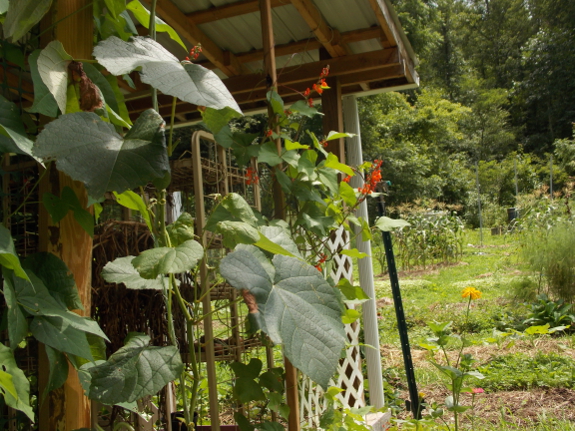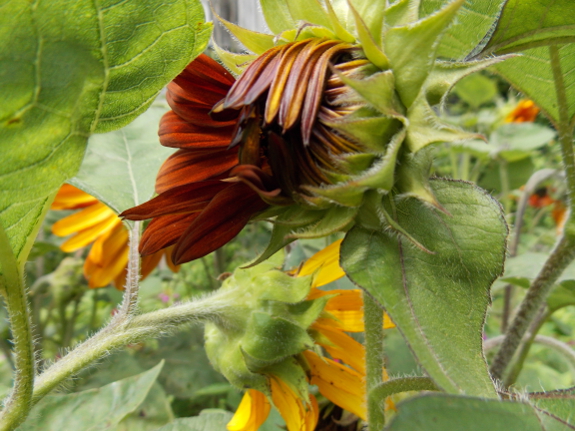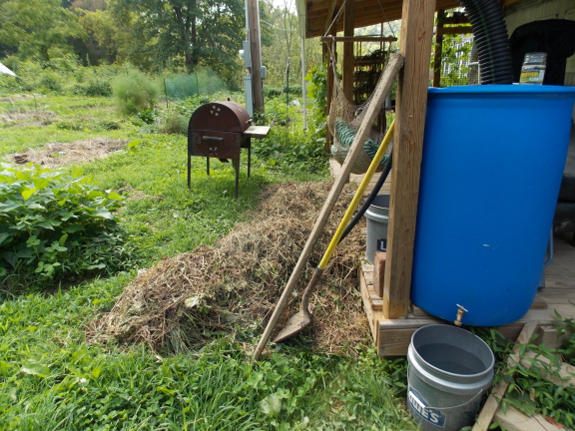
A colorful summer

I've been surprised by
how much joy I've gotten out of flowers this year. I always put
the bare minimum amount of effort into non-edible plants, choosing the
easiest annuals and perennials that survive lots of neglect.
Zinnias, sunflowers, touch-me-nots, and scarlet runner beans seem worth
replanting using my lazy methods, and echinacea and bee balm have
already survived years of neglect.

From the perspective of
the local wildlife, sunflowers are probably the top choice among my
for-show flowers --- I definitely see more bugs there than on my other
"useless" plants. I've been enjoying the hummingbird who claimed
our patch of scarlet runner beans, though --- she drops by multiple
times a day and has been busy chasing off the competition.

Part of the reason I've
gotten so much bang for my buck from flowers this year is that I started
a patch in front of the trailer where we can see the flowers from the
couch and from the outdoor table. So I'm dumping weeds along
another section of the front porch this summer to give a little
fertility to soil that will become flowers next year. No, flowers
aren't worth wasting cardboard on, but this lazy kill mulch will do its
job pretty well anyway.
I'm curious to hear from
other similarly lazy flower gardeners. Which species make the cut
among your low-work annuals and perennials?
Want more in-depth information? Browse through our books.
Or explore more posts by date or by subject.
About us: Anna Hess and Mark Hamilton spent over a decade living self-sufficiently in the mountains of Virginia before moving north to start over from scratch in the foothills of Ohio. They've experimented with permaculture, no-till gardening, trailersteading, home-based microbusinesses and much more, writing about their adventures in both blogs and books.
Want to be notified when new comments are posted on this page? Click on the RSS button after you add a comment to subscribe to the comment feed, or simply check the box beside "email replies to me" while writing your comment.

I agree, sunflowers and red runner beans are great. I wonder with your zone if tulips would survive the wet ground. They are plant and forget. Some day I will get some flowering ground cover in. The kind that can be walked on I between the aisles.
Mark --- In my ultra-low-work method, marigolds have failed to come up in the past. However, I am trying them again this year, courtesy of a 10 cent pack of seeds from the Dollar Store, and they look like we might actually get blooms...
Sweetgum --- I've wanted to grow borage, but the one time I tried them, they didn't survive the extreme neglect I give flowers. However, if you find them pretty easy, it might be worth starting a few in flats just to get them going on the farm, now that our vegetable garden is more in control than it was in early years. I'm now willing to give flowers 5% of the attention they deserve instead of 1%....
I did grow cosmos for a year or two, and they survived my extreme neglect. But the plants tend to fall over, which puts them out of my ultra-low-work category. Maybe worth growing again now that I have spots up against the side of the house, though....
We do grow poppies for seeds, and I had columbine and fennel going for a while until I mowed over them. (Oops.) Maybe I should start those again.
Faith --- I just realized I had a typo in my post where I mentioned "echinacea and coneflowers" (which are the same thing) instead of "echinacea and bee balm. I agree --- bee balm is an awesome easy flower!
Kathleen --- I think we might have a tulip or two, but they fade fast in our climate. They definitely are plant-it-and-forget-it, though.
Maggie --- I've always felt daylilies were too invasive --- in my mom's yard, they have to be ripped back so they don't take over the world.
I'd never even heard of portulacca (I know nothing about ornamental flowers). We don't have many dry, sunny areas, but that would be possible.
Here is a list of flowers that have survived fairly severe neglect in our yard: Daffodils, bachelor buttons, yarrow, thyme, blanket flower, shasta daisy, purple cone flower, cosmos, black eyed susan, maypop, sun flowers, zinnias and this year is our first for scarlet runner beans and sunchokes. I'm sure I missed some in there too. We started many more from broadcasting seeds but they either didn't survive more than a year or couldn't survive the heat.
Do blue flowers attract bees? Irises and bluebells (I have those from Mass. so they are not Va. bluebells), I'll add, since they are perennials. Ground ivy is special, for me, because of its spicy smell, but I guess you call it a weed. (I wanted to try larkspur, but didn't this year.)
Don't forget the good white bells on comfrey. and flowers on the mint family.
Phlox is special, to me, not the wild, but the tame, which will come back.